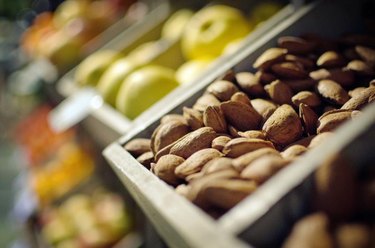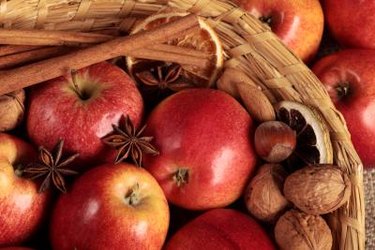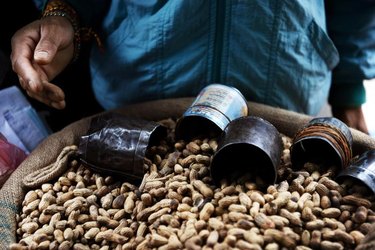
The answer to the age-old question of whether nuts are a fruit or a vegetable depends on the angle you use to define them. Fruits are the seed-bearing product of a flowering plant, while vegetables are any other part of the plant, including stems, leaves and roots. A nut can be a fruit in that it is the fruit of its tree, yet it can be likened to a legume vegetable due to its high-protein content and the fact that it might have grown underground. The key to distinguish the two is in a nut's origins and its nutritional composition.
Drawing a Line Between Seeds & Fruits
Video of the Day

Nuts are fruits – except when they're not. "They are defined as dry, single-seeded fruits that have high oil content," according to the U.S. Forest Service. "They are usually enclosed in a leathery or solid outer layer. In botany terms, nuts are strictly a particular kind of dry fruit that has a single seed, a hard shell, and a protective husk."
Video of the Day
Tree nuts such as chestnuts, hazelnuts, pecans and walnuts are the fruit of their trees. Almonds, for example, grow on trees of the same genus as those that give us fruits such as plums, apples, peaches and cherries. Despite this distinction, almonds are considered tree nuts and the almond industry is represented by the nonprofit International Tree Nut Council Nutrition Research & Education Foundation, along with eight others: Brazil nuts, cashews, hazelnuts, macadamias, pecans, pine nuts, pistachios and walnuts.
For the purpose of identifying the "tree nut" food allergen, the U.S. Food and Drug Administration categorizes the following as tree nuts: almond, beech nut, Brazil nut, butternut, cashew, chestnut (Chinese, American, European, Seguin), coconut, ginko nut, hickory nut, pecan, pine nut, pili nut, pistachio, shea nut, walnut (English, Persian, black, Japanese, California), heartnut and butternut.
The Protein Component of Nuts

In comparison with tree nuts, nuts classified as part of the legume vegetable group grow underground. Peanuts form part of this group and have a dietary profile in line with meat protein. They can be counted as one or the other when structuring a healthy, balanced meal, the "2015-2020 Dietary Guidelines for Americans" notes. And, no, you can't count a handful of peanuts as a meal — bolster your meal's legume portion with either green vegetables or a meat protein.
The "Dietary Guidelines," based on a 2,000-calorie diet, recommends a daily consumption of 5.5 ounce-equivalents of protein foods, 2.5 cup-equivalents of vegetables, 6 ounce-equivalents of grains, 3 cup-equivalents of dairy (for adolescents and adults) and 2 cup-equivalents of fruit. "One-half ounce of nuts or seeds counts as 1 ounce-equivalent of protein foods, and because they are high in calories, they should be eaten in small portions and used to replace other protein foods rather than being added to the diet," according to the guidelines. "When selecting protein foods, nuts and seeds should be unsalted, and meats and poultry should be consumed in lean forms."
In its "Peanut Facts," the Peanut Institute describes legumes as "edible seeds enclosed in pods. As a group, they provide the best source of concentrated protein in the plant kingdom. While their physical structure and nutritional benefits more closely resemble that of other legumes, their use in diets and cuisines more closely resembles that of nuts."
Similarly, tree nuts overall offer a meatlike protein profile. In a nutrient comparison chart comparing the nutritional components of almonds and tree nuts, the Almond Board of California notes that almonds are highest in protein – offering 6 grams per 1-ounce portion – as well as in fiber, calcium, vitamin E, riboflavin and niacin. Macadamia nuts and pecans are among the protein slackers in the group, providing only 2.2 and 2.6 grams of protein, respectively, per 1-ounce portion. Although tree nuts such as these are the fruit of their respective trees, they are closely aligned with legume vegetables when defined by their nutritional composition.